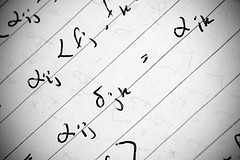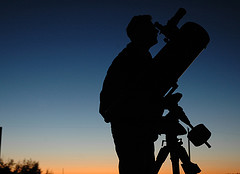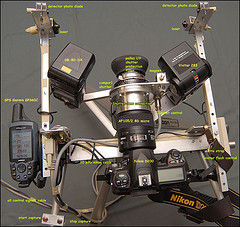June 18th, 2009 by Eugene Barsky | No Comments »

A short article from last month in the New Scientist discussed the changes in quantum computing in the last decade. Another related article from the April’s Science could also be of interest – “Where Is My Quantum Computer?”
See more research about quantum computing in the Web of Science database that UBC subscribes to. Here are 180 articles retrieved for my quick search for “quantum comput*” and secur* (you need a subscription to this database to view the results).
** Photo by All Glass
Posted in General Science, Main, Physics, Uncategorized | No Comments »
June 9th, 2009 by Eugene Barsky | No Comments »

Thomson Reuters has released its latest figures for Canadian Science last week – http://sciencewatch.com/dr/sci/09/may31-09_2/
Between 2004 and 2008, Thomson Reuters indexed 226,232 papers that listed at least one author address in Canada. Of those papers, the highest percentage appeared in journals classified under the heading of environment/ecology, followed by psychiatry/psychology and geosciences. As the right-hand column shows, the citations-per-paper average for environment/ecology papers from Canada-based authors was 24% above the world average in the field (5.49 cites per paper for Canada versus 4.43 cites for the world). In fact, in all the fields shown here, the impact of Canadian research exceeded the world average, with particularly strong performance in space science (44% above the world average), physics (43% above), and agricultural sciences (+29%).
It is great to see that we are producing a decent share of world’s research. But it seems that Engineering is one of weak points!
** Photo by tripleman
Posted in Astronomy, Atmospheric Science, Chemical and Biological Engineering, Chemistry, Civil Engineering, Earth and Ocean Sciences, General Science, Geography, Main, Materials Engineering, Mathematics, Mechanical Engineering, News, Physics, Science - undegraduate classes, Statistics, Wood Sciences | No Comments »
May 29th, 2009 by Kevin Lindstrom | No Comments »
The following presentations including audio and visual when available are now online from cIRcle, the UBC Library’s digital repository.
- Building an organization that can build a quantum computer Rose, Geordie
- The Dark Side of the Universe Van Waerbeke, Ludovic
- Frontiers in Nuclear Theory: From Light Nuclei to Astrophysics Bacca, Sonia
- Identifying, measuring, and teaching physics expertise Wieman, Carl
- Snowflakes, Stress and Semiconductors: Do You See a Pattern Here? Taylor, Richard
Submitted by Kevin Lindstrom Liaison Librarian for Physics and Astronomy
Posted in Astronomy, General Science, Physics, Podcasts | No Comments »
May 21st, 2009 by Eugene Barsky | No Comments »

In celebration of the International Year of Astronomy in 2009, New Scientist takes you on an armchair tour of some of the most important telescopes ever built – http://www.newscientist.com/gallery/dn16663-important-telescopes
UBC Library owns dozens of books on telescopes. See some of them here- Telescopes.
** Photo by Space Ritual
Posted in Astronomy, Atmospheric Science, Earth and Ocean Sciences, General Science, Geography, Main, Physics | No Comments »
May 15th, 2009 by Kevin Lindstrom | No Comments »
The 11th Annual Meeting has come to Vancouver. Running from May 14 – May 16th, this annual meeting attracts physicists from the Pacific Northwest including Alberta.
Topics range from Finding and Characterizing Extrasolar Planets to relativistic non-instantaneous action-at-a-distance interactions.
For more information, go to the APS Northwest Chapter website.
Friday’s morning Welcome and Plenary Session were recorded and will be available online shortly from cIRcle
Submitted by Kevin Lindstrom Liaison Librarian for Physics and Astronomy
Posted in Astronomy, Physics | No Comments »
May 8th, 2009 by Kevin Lindstrom | No Comments »
Statistics isn’t just about bayesian disease mapping and analyzing incomplete multivariate data. Statistics has some very important applications for analyzing hockey – yes, ice hockey. While my team hasn’t made the playoffs for a while except for that glorious 2006 run, it might be interesting to for any of you hockey statisticians to apply the research to the teams currently playing in the NHL playoffs.
Here’s a sample of some the articles available in MathSciNet and Current Index to Statistics dealing with ice hockey.
Thomas, Andrew C. (2007) “Inter-arrival Times of Goals in Ice Hockey,” Journal of Quantitative Analysis in Sports: Volume 3: Issue 3, Article 5. Available at: http://www.bepress.com/jqas/vol3/iss3/5
Thomas, Andrew C. (2006) “The Impact of Puck Possession and Location on Ice Hockey Strategy,” Journal of Quantitative Analysis in Sports: Volume 2: Issue 1, Article 6. Available at: http://www.bepress.com/jqas/vol2/iss1/6
Anthology of Statistics in Sports. Edited by Jim Albert, Jay Bennett and James J. Cochran. ASA-SIAM Series on Statistics and Applied Probability, 16. 2005.
Gill, Paramjit S. (2000) “Late-Game Reversals in Professional Basketball, Football, and Hockey” The American Statistician, Volume 54, Number 2 (May, 2000), pp. 94-99 http://www.jstor.org/stable/2686024
The Journal of Quantitative Analysis in Sports is a great place to browse.
Submitted by Kevin Lindstrom UBC Science and Engineering Librarian
Posted in Amusing stuff, Atmospheric Science, Chemical and Biological Engineering, Chemistry, Civil Engineering, Earth and Ocean Sciences, General Science, Geography, Main, Materials Engineering, Mathematics, Mechanical Engineering, News, Physics, Podcasts, Science - undegraduate classes, Statistics, Uncategorized, Wood Sciences | No Comments »
April 24th, 2009 by Kevin Lindstrom | No Comments »
Canada Excellence Research Chairs – Phase 1 Competition Results
Overview
In 2008, the Government of Canada created a new permanent program to establish 20 prestigious research chairs–Canada Excellence Research Chairs (CERC)–in universities across the country. The CERC program invests $28 million a year to attract and retain the world’s most accomplished and promising minds and help Canada build a critical mass of expertise in the priority research areas of environmental sciences and technologies, natural resources and energy, health and related life sciences and technologies, and information and communication technologies.
Phase 1 Competition Results
The following 17 universities have been invited to compete in Phase 2.
Universities invited to Phase 2 competition
(Number of successful proposals arranged from West to East)
* University of British Columbia (4)
* University of Alberta (5)
* University of Calgary (1)
* University of Saskatchewan (1)
* University of Manitoba (1)
* University of Toronto (5)
* University of Waterloo (4)
* McMaster University (2)
* Queen’s University (1)
* University of Western Ontario (2)
* University of Ottawa (2)
* McGill University (4)
* Université Laval (3)
* Université de Sherbrooke (1)
* Université du Québec à Trois-Rivières (1)
* University of Prince Edward Island (1)
* Dalhousie University (2)
Click here for a list of the successful proposals
Submitted by Kevin Lindstrom Liaison Librarian
Posted in About this blog, Amusing stuff, Atmospheric Science, Chemical and Biological Engineering, Chemistry, Civil Engineering, Earth and Ocean Sciences, General Science, Geography, Main, Materials Engineering, Mathematics, Mechanical Engineering, News, Physics, Podcasts, Science - undegraduate classes, Statistics, Teaching, Uncategorized, Wood Sciences | No Comments »
April 16th, 2009 by Eugene Barsky | No Comments »

Since early April 2009, the access to INIS database has been opened to all Internet users around the world. Free, open and unrestricted access is available from the INIS Homepage, or directly from the following link: INIS Database.
This initiative provides easy access to reliable nuclear information on the peaceful uses of nuclear science and technology, including nonconventional literature, and makes nuclear knowledge readily available worldwide.
Established in 1970, INIS represents the world’s largest database of scientific and technical literature on a wide range of subjects from nuclear engineering, safeguards and non-proliferation to applications in agriculture, health and industry.
Currently, the INIS Database contains over 3 million bibliographic records and almost 200,000 full-text nonconventional documents, consisting of scientific and technical reports and other non copyrighted information.
** photo by clark
Posted in Atmospheric Science, Chemical and Biological Engineering, Chemistry, Earth and Ocean Sciences, General Science, Main, News, Physics, Science - undegraduate classes, Uncategorized | No Comments »
March 25th, 2009 by Eugene Barsky | No Comments »

Educause has released its new report – “7 Things You Should Know About Location-Aware Applications“.
Location-aware applications deliver online content to users based on their physical location. Various technologies employ GPS, cell phone infrastructure, or wireless access points to identify where electronic devices such as mobile phones or laptops are, and users can choose to share that information with location-aware applications. As mobile devices offer greater amounts of data about the environment through which we move, location-aware systems will become increasingly effective at predicting what users would like to know about in the geographical space around them, offering a layer of knowledge superimposed on the physical world that can be accessed for information and convenience.
You can research this topic in many of our online databases, however, IEEE digital Library would be your first source. Try this search in IEEE database – http://tinyurl.com/d6y5aj
** Photo by fotoopa
Posted in Amusing stuff, General Science, Geography, Main, Mathematics, Physics, Science - undegraduate classes | No Comments »
March 6th, 2009 by Kevin Lindstrom | No Comments »
The 2009 UPPAC conference takes place on Saturday March 14, 2009 at the Hennings Building here on the UBC Vancouver campus.
The Undergraduate Pacific Physics and Astronomy Conference is the conference where undergraduate students from Western Canada and the Pacific Northwest can share their research, learn about further opportunities for research and education, and meet other undergraduate students. UPPAC features undergraduate research talks, lab tours, a keynote lecture by a distinguished researcher, and lots of opportunities for undergraduate students to network and to explore Vancouver and the UBC campus.
For an example of papers presented at last years conference, have a look at the 2008 UPPAC Conference Proceedings.
Submitted by Kevin Lindstrom Liaison Librarian for Physics and Astronomy
Posted in General Science, News, Physics, Science - undegraduate classes | No Comments »





